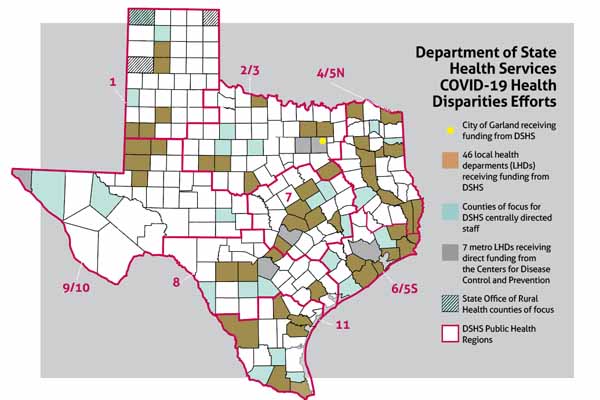
It’s a short-term federal grant that Stephen Pont, MD, hopes can make a long-term impact.
In public health circles, it’s been clear for some time that social factors are an impactful driver of a person’s health needs. And as COVID-19 came to dominate life in the U.S. over a two-year period, it became increasingly clear that the pandemic was widening long-standing health disparities.
The Texas Department of State Health Services (DSHS) – where Dr. Pont is medical director of the Center for Public Health Policy and Practice – is using a $45.2 million grant from the Centers for Disease Control and Prevention (CDC) to get a picture of just how much COVID has widened those chasms, and to work to close them.
The money, which Texas is receiving from June 2021 through summer 2024, is going toward:
- Dozens of local health departments to determine how they can best address food insecurity, transportation needs, and other socially driven health gaps;
- New staff focused on health disparity;
- Approaches to improve preven-tive care to avoid obesity and chronic disease; and
- Listening sessions and focus groups in unhealthy communities around the state.
“The pandemic has shone a light on challenges that we’ve known have been there, and this additional CDC funding has created opportunities to address these disparities in new ways,” Dr. Pont told Texas Medicine. “As the Department of State Health Services, we’re concerned with the health of everybody in Texas. But we know that some in Texas are disproportionately impacted by various health conditions, COVID being one of them.”
Areas of need
The DSHS grant is one aspect of an emerging state response to an emerging area of study. (See “Closing the Loop,” page 22.)
The department’s Center for Public Health Policy and Practice is overseeing the $45 million COVID disparities grant through its Office of Public Health Policy and Performance and Office of Practice and Learning. Texas is distributing about half of the money to 46 local health departments that requested assistance. Those recipients largely make up rural and underserved sectors of the state. (See map, page 46.)
The local health departments are directing their slice of the funding based on their unique needs. According to a DSHS overview of the program, target communities include rural communities, racial and ethnic minorities, the chronically ill, people with disabilities, and LGBTQ communities, among others.
“Health disparities would be defined as any communities that were disproportionately impacted by COVID,” Dr. Pont said. “[We] know that many factors contribute to these disparities: socioeconomically challenged communities, rural communities. Race and ethnicity are a part of that as well.”
Local action
DSHS is using the other half of the funds for collaborations with other state agencies, including the State Office of Rural Health; the Texas Parks & Wildlife Department; and Texas A&M AgriLife Extension Services, a statewide network of educators, county offices, and volunteers that helps address a number of local policy needs, including enhancing food security and “protecting human health through education about diet, exercise, and disease prevention and management.”
Part of the state plan involves beefing up personnel in health disparity hot spots. That includes making two grant-funded hires of its own for each of the state’s eight public health regions – a community engagement specialist and a performance improvement specialist – and Texas A&M AgriLife hiring one health disparities specialist in each region. That makes a total of 24 new specialists spread across the state, with each trio covering one public health region. Each of the eight regions will have three “counties of focus.” Staff from DSHS and AgriLife also will host listening sessions and focus groups to understand those communities’ priorities and needs. DSHS says it has hired 12 out of its 16 new regional staff positions thus far.
The goals include increasing rural access to preventive care, decreasing emergency medicine costs, and reducing the severity and incidence of health conditions that lead to worsened COVID comorbidity.
One way the rural health office is doing that is by implementing a pilot Community Paramedicine Program to improve rural preventive care in four counties in the Texas panhandle: Collingsworth, Dallam, Deaf Smith, and Lipscomb. The program will expand the roles of emergency medical services staff – paramedics and emergency medical technicians – to include preventive checkups and education.
“There have been a number of impactful community paramedicine programs around the state, and some of those have been around for a number of years,” Dr. Pont said. “But helping these panhandle communities is somewhat new, and we’re pretty excited about it.”
The partnership with Texas Parks & Wildlife aims to prevent obesity and reduce other chronic diseases that can occur from not spending enough active time outdoors and having less access to “green spaces” for physical activity or recreation. The parks department, through the Texas Children in Nature Network, planned to hire community health and nature liaisons to improve access to nature and develop programs for vulnerable populations.
“This is building on what we know about COVID: that it is safer to be outdoors. We also know just generally that time outdoors is healthy time, and that time in nature has additional positive health benefits as well. What we have always known is now becoming more documented in the research literature,” Dr. Pont said. “The goal is to get more Texans outdoors and active, and for them to engage and enjoy our state’s natural resources for the physical activity benefits and for the mental health benefit as well.”
DSHS is collaborating with health departments in larger metro areas to share best practices in fighting health disparities. The “big seven” major-metro jurisdictions – including Austin-Travis, Bexar, Dallas, and Harris counties – received separate, direct CDC funding for the same purpose.
Tex Med. 2022;118(5):46-47
May 2022 Texas Medicine Contents
Texas Medicine Main Page